Monitoring and surveillance in Amboseli National Park Summary: The Southern Conservation Area Mobile Veterinary Unit during the month decided to perform an aerial recce within the park and surrounding ecosystem
Monitoring and surveillance in Amboseli National Park
Summary:
The Southern Conservation Area Mobile Veterinary Unit during the month decided to perform an aerial recce within the park and surrounding ecosystem. The DSWT provided an aircraft for this activity which took one hour. This was due to the increased number of spear and arrow attack cases observed after human wildlife conflict. The purpose of this exercise was to; - See the distribution of wildlife within the park -Check for injured/sick animal within the park -Check for any unnoticed carcasses within the park and its surrounding ecosystem -Check for any unusual activites or happenings within the park. No unusual sighting was seen except for two elephant carcasses which had earlier been sighted.
Case #1 Report of an orphaned Rhino (follow up) :
Date: 6th July 2014
Species: Black Rhino
Sex: Male
Age: 1 - 1.5 years
Location: Mukururo (Chyullu National Park)
History:
The young rhino was orphaned after the death of the mother on 06-06-14 in Mukururo (Chyullu hills National Park). A ground and air team tried to rescue the orphan who had a gun shot injury around the neck region. However the rhino became elusive and has since not been spotted physically. The big life foundation laid camera traps around the region where regular tracks could be seen for monitoring purposes. The rhino has been seen and has greatly improved. The wound healed, in good health and proved capable of living in the wild on its own.
Conclusion:
The rhino can be allowed to live in the wild under surveillance and monitoring of the rangers within the region. This is after the following considerations: -Age of the rhino-1-1.5 years -Able to feed on forage in the wild in absence of the mother. -In good health. -The orphan has managed to adopt living on his own and survived for quite a considerable period. -The bullet injury has healed with time -The rhino has also proved elusive a sign that he is capable of living in the wild with minimal threat.
Case #2 Treatment of injured elephant:
Date: 17th July 2014
Species: Elephant
Sex: Male
Age: 35 - 40 years old
Location: Selegai, Amboseli National Park
G.P.S position: 37 m 0311284 Utm 9741294
History:
A male elephant was reported to be lame and having an injury on the right hind limb. The elephant had been previously collared and therefore the veterinary, Kws research and Ifaw team set off to locate the elephant. The elephant proved difficult to locate in the thick bush despite using the tracking gadgets. However, the team finally got the elephant after an hour of searching, The wound was assessed and a decision to immobilize the elephant was made.
Immobilization:
The elephant was immobilized using 18 mgs Etorphine Hydrochloride in a 3cc dart toped up using water for injection. Foot darting was done using Dan-inject system due to the thick Vegetation. The elephant stood still and after effects of the narcotics took place, he dashed into the thick bush. The team then embarked on a ground search operation since the transmitters on the elephant failed due to poor transmission. The elephant was finally located safe and sound after a 1.5 hrs search. The elephant was redarted since he had regained conscious after full metabolism of the first immobilization dose. The trunk was maintained patent using a piece of stick placed across the nostril entrances. The temperature was high hence plenty of water was doused on the elephant to keep the body temperatures low. The ears were used as blindfold.
Examination and Treatment:
On physical examination the elephant had an approximately 15 cm long wound (3 weeks old) on the right hind limb at the digits. The wound was penetrating and had two openings. It was septic and had necrotic tissue. The wound is likely to have been caused by a branch or stick that had penetrated through the limb and had come off with time. The dead tissue was debrided and removed. The wound was then thoroughly cleaned using water and Hydrogen Peroxide. It was then lavaged using tincture of Iodine. Topical antibiotic cream and green clay was then applied into the wound to facilitate healing and avoid infection. The elephant was then injected with 100 ml Betamox L.A and 100 ml Dexamethasone at different sites intramuscularly. The entire operation lasted about 20 minutes.
Reversal of immobilization:
Diprenorphine Hydrochloride (66mgs) into the ear vein was used. It took about 8 minutes to be fully awake; Prognosis:Good
Treatment of the wound


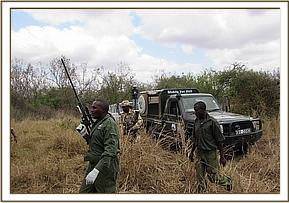

Case #3 Giraffe case:
Date: 12th July 2014
Species: Giraffe
Sex: Male
Age: Adult
Location: Osewan, Amboseli National Park
History:
A male giraffe was spotted by rangers in the group ranch and reported to have been lame. They reported to the veterinary team who attended to the case immediately for examination and treatment.
Immobilization:
The giraffe was recumbent and immobile on arrival at the scene. Immobilization was therefore not necessary for examination and assessment of the injury to be done.
Examination:
On physical examination the giraffe had suffered from an open compound and comminuted fracture (left hind limb) at the hock joint. A decision to euthanize the giraffe was made.
Post Mortem:
An incision into the fracture was made to expose the extent of the injury. Bone fragments were retrieved from the hock joint. The giraffe could have suffered from a fall which led to the severe fracture.
Prognosis:
The prognosis was poor and chances of recovery even with clinical intervention were nil and therefore the giraffe had to be sadly euthanized.
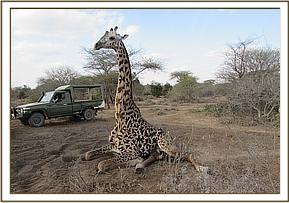
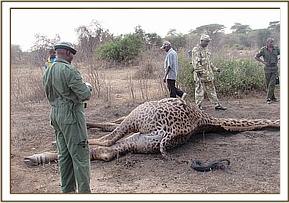
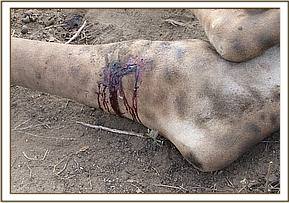
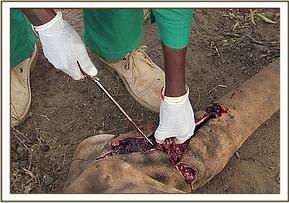

Case #4 Postmortem report of an elephant:
Estimated date of death: 23rd July 2014
Date of Post Mortem: 25th July 2014
Species: Elephant
Sex: Female
Age: 9 years
Location: Satao (Amboseli ecosystem)
GPS position: 37m0321404 Utm9692088
History:
Herders reported on 25-07-14 at about 1.30pm to the KWS security personell of having spotted a dead elephant within the area of Satao. The management then reported to the veterinary team and also dispatched a team of rangers to the scene. The team found the carcass intact and embarked on postmortem and removal of tusks for safe custody. The tusks were then delivered to the Amboseli N.P headquarters.
General and Physical examination of the carcass:
On general examination, the animal was in a fair body condition and was lying on the right lateral side adjacent to a cliff. There were also signs of struggle above the cliff indicating that she must have fallen off the cliff just at about the time of her death. She had a penetrating wound on the left abdominal region caudal to the umbilical region. The penetrating object had penetrated into the gut about 15 cm from the spinal region suspecting the attacker to have positioned himself from the top of a cliff or a tree. The carcass was then flipped to left lateral recumbency for further examination. No other external injury was visible on the left abdominal region. The wound was probed for any foreign objects but none was observed.
Examination of the opened carcass:
On incising across the penetrating wound, the wound was fairly fresh (about 24 hrs) and had also penetrated into the abdomen. The gut had been raptured by a penetrating object. The wound was about 7 cm in diameter and had penetrated into the gut.
Cause of death:
Taking into consideration the size and age of the wound, the elephant succumbed to death as a result of toxicity from a spear laced with some lethal poison.
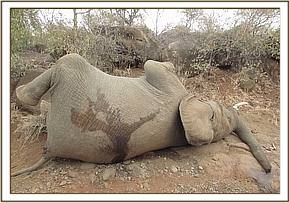
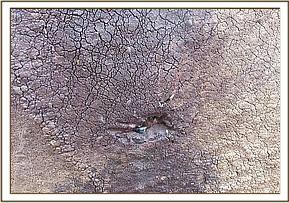
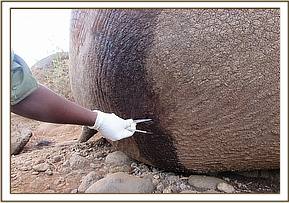


Case #5 Treatment of injured elephant:
Date: 23rd July 2014
Species: Elephant
Sex: Male
Age: 30-35 yrs
Location: Kamboyo, Tsavo West National Park
History:
The DSWT pilot reported a case of an injured male elephant to the S.C.M.V.U based at the Amboseli. N.P and immediately made plans to airlift the veterinary doctor and rangers to Komboyo. Plans were also made to have the DSWT helicopter and the KWS aircraft on sight for easy sighting and darting. On arrival, the elephant was in a bush thicket and proved difficult to locate and dart him. A decision to postpone the exercise to the following day was arrived to after darkness threatened to set in. Success met the team the following day after successful helicopter darting and treatment.
Immobilization:
The elephant was immobilized using 18 mgs Etorphine Hydrochloride in a 3cc dart toped up using water for injection. Darting was done using the Dan Inject system and was relatively easy from a helicopter despite the thick vegetation. The ground team was well guided from a light aircraft to the position of the recumbent elephant. It was initially on dog sitting position but later on his own went to lateral recumbence. The trunk was maintained patent using a piece of stick placed across the nostril entrances. The temperature was high hence plenty of water was doused on the elephant to keep the body temperatures low. The ears were used as blindfold.
Examination and Treatment:
On physical examination the elephant had an approximately 15 cm long wound (1-2 weeks old) on the right flank region but close to the hip region. The wound was septic and had necrotic tissue. An incision was made distal to the wound where there was a pus pocket to allow access and drainage of pus from the wound. The wound is likely to have been caused by an arrow head which had come off with time. The dead tissue was debrided and removed. The wound was then thoroughly cleaned using water and Hydrogen Peroxide. It was then lavaged using tincture of Iodine. Topical antibiotic cream and green clay was then applied into the wound to facilitate healing and avoid infection. The elephant was then injected with 100 ml Betamox L.A and 100 ml Dexamethasone at different sites intramuscularly. The entire operation lasted about 20 minutes.
Reversal of immobilization:
Diprenorphine Hydrochloride (54mgs) into the ear vein was used. It took about 6 minutes to be fully awake from anaesthesia.
Prognosis:
Prognosis is good.
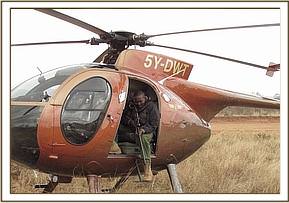
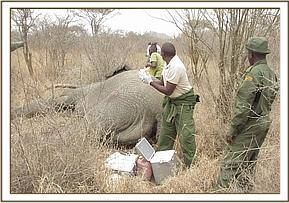
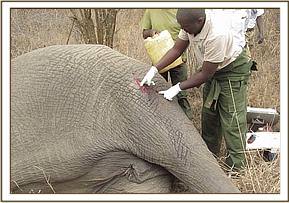
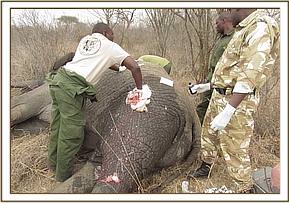
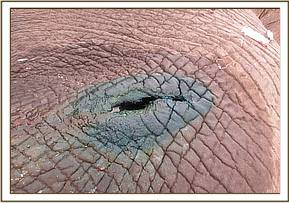

Case #6 Post Mortem Report of adult elephant:
Date of Autopsy: 21st July 2014
Species: Elephant
Sex: Female
Age: 40- 45 years
Location: Amboseli National Park
GPS: 037m 0307248 UTM 9703272
History:
An elephant carcass was seen on 21-07-2014 at day time around 5.00 pm by KWS security personnel while on patrol.
General post mortem findings:
The elephant had been lying on a bare ground for quite a considerable period of time. Both elephant tusks were present. The KWS security personnel removed the tusks with ease. The carcass had been mauled by scavengers and only disintegrated parts of the skeleton could be seen suggesting that the carcass could have been there for a estimated ti me of 1 – 1.5 months old.
Procedure:
The KWS security personnel removed the tusks and delivered them to Amboseli National park head quarters for safe custody. The tusks were weighed prior to storage and weighed 22 kg and 21 kg.
Cause of death:
The cause of death could not be established.
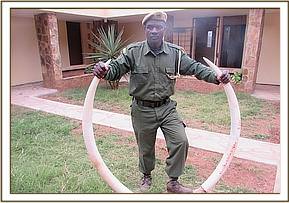

Case #7 Post Mortem Report of adult elephant:
Date: 23rd July 2014
Species: Elephant
Sex: Female
Age: 30- 35 years Location: Amboseli National Park
GPS: 037m 0310441 UTM 9700758
History:
An elephant carcass was reported to have been seen on 23-07-2014 at day time around 2.00 pm by wildlife security personell within the park.
General post mortem findings:
The elephant was on lateral recumbence position in a bareground. Few maggots were present and the carcass had decomposed hence estimating the time of death to have been 1-2 weeks prior to sighting of the carcass. Both elephant tusks were missing indicating there was some human interference. All the internal organs were missing.
Examination:
On physical examination, no physical injury was observed on the carcass. At the head region, there seemed to have been a cut with a sharp object after death of the elephant probably an aftermath of the removal of the tusks.
Procedure:
The KWS security personnel using the intelligence department and the community were able to trace the whereabouts of the missing tusks and were able to recover them. The tusks were delivered to the Amboseli National Park headquarters for safe custody. The tusks were weighed prior to storage.
Cause of death:
Taking into consideration: -No physical injury observed on the carcass -Quick recovery of the missing tusks. The elephant could have died out of a disease or through oral poisoning from the community farms.
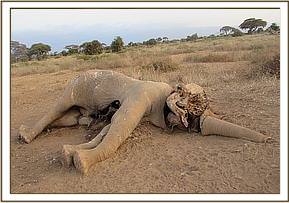
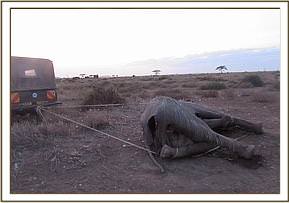

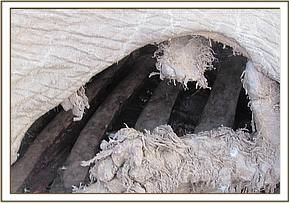

Case #8 Zebra case:
Date: 19th July 2014
Species: Zebra
Sex: Male
Age: Adult
Location: Amboseli National Park
History:
A male injured zebra was spotted by the veterinary team while on patrol/animal census exercise. The veterinary team immediately made a decision to immobilize, examine and the zebra.
Immobilization:
The zebra was immobilized using 7 mgs Etorphine Hydrochloride and 60 mg azerperone in a 3cc dart toped up using water for injection. Darting from a vehicle was done using Dan-inject system. Full immobilization took place after 5 minutes and he fell on lateral recumbence. The zebra was blind folded and opticlox applied to the eyes to avoid damage.
Examination:
On physical examination the zebra had a deep and long sharp edged cut on the flank region which could have been caused by a predators attack. The wound was septic, about 75 cm long and gaped.
Treatment:
The wound was thoroughly cleaned using clean water, hydrogen peroxide and normal saline for rinsing. There was lots of pus and necrotic tissue in the wound. The dead tissue was debrided and removed. It was then lavaged using tincture of Iodine. Topical antibiotic cream and green clay was then applied into the wound to facilitate healing and avoid infection. The zebra was then injected with 50 ml Betamox L.A and 100 ml Dexamethasone at different sites intramuscularly. The entire operation lasted about 20 minutes.
Reversal:
Revesal of immobilization was done using 18 mg diprenorphine HCL and took about 3 minutes for complete reversal.
Prognosis:
The prognosis is good.
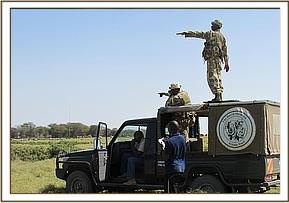
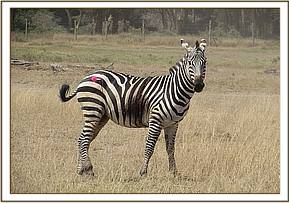
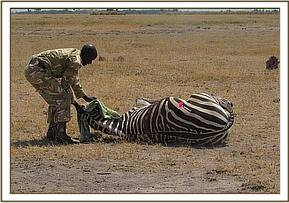

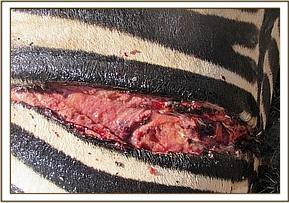

After reversal of immobilization:
The Southern Conservation Area Mobile Veterinary Unit is grateful to all individuals and organisations that played a role in assisting us towards achieving our goal. Many thanks to The David Sheldrick Wildlife Trust, The Samuel J and Ethel Lefrak charitable trust and The Kenya Wildlife Service for their continued support to this unit which aims at immediate response to clinical intervention, wildlife rescues and alleviating wildlife suffering.
Report by: Dr. Michael Njoroge.